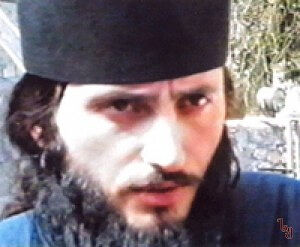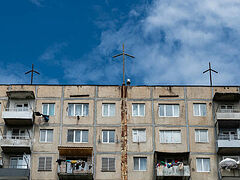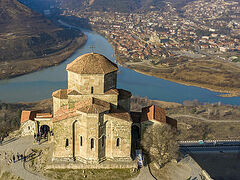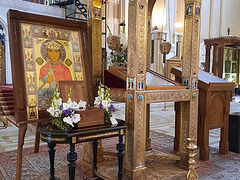Throughout the history of the Georgian people, one of the main ways that the faith has been nourished is through the near-constant sacrifice of the martyrs ranging from those who suffered during the Zoroastrian Sasanian (Iranian) invasions of the sixth century A.D. to the twentieth century with the numerous Georgian New Martyrs under the Soviet Union (1921 to 1992). These models of Georgian Christianity offered themselves out of pure love to join their Savior and as a sacrifice for the sins of the Georgian people throughout the centuries. A multitude of Georgian martyrs have been added to the Church calendar and are highly venerated by the Georgian faithful. Millions more Georgian martyrs are not known by name, but their sacrifice remains timeless in helping to spiritually feed the Georgian Church in its times of struggle. In the transition from the Soviet Union to an independent nation, the Georgian Church was granted one more New Martyr, whose sacrifice would signal the end of martyrdom for the Georgian people in the twentieth century.
 Yesterday, July 7, the feast of the Nativity of St. John the Baptist, was the date of the burial of the Georgian New Martyr Fr. Andria, who was killed as a result of post-Soviet secular nationalism. On July 5, 1993, the village of Kamani near Sokhumi, Abkhazia (formerly a region of Georgia) fell to Apsuan separatists, and at twenty-nine years of age, Hieromonk Andria (Kurashvili, ყურაშვილი) died a martyr. Kamani is one of the most beautiful villages in Abkhazia and is fifteen kilometers from Sokhumi. To the north is the Gumsta River, a land surrounded by mountains, and in this humble village St. John Chrysostom gave up his soul after a long period of exile. But this beauty did not spare the village from the flames of war that would spread throughout the territories of the Soviet Union—including Georgia—after its dissolution.
Yesterday, July 7, the feast of the Nativity of St. John the Baptist, was the date of the burial of the Georgian New Martyr Fr. Andria, who was killed as a result of post-Soviet secular nationalism. On July 5, 1993, the village of Kamani near Sokhumi, Abkhazia (formerly a region of Georgia) fell to Apsuan separatists, and at twenty-nine years of age, Hieromonk Andria (Kurashvili, ყურაშვილი) died a martyr. Kamani is one of the most beautiful villages in Abkhazia and is fifteen kilometers from Sokhumi. To the north is the Gumsta River, a land surrounded by mountains, and in this humble village St. John Chrysostom gave up his soul after a long period of exile. But this beauty did not spare the village from the flames of war that would spread throughout the territories of the Soviet Union—including Georgia—after its dissolution.
During the Abkhazi war, parishioners were often seized with despair and fear, but Hieromonk Andria’s modest smile, speech, and tranquility comforted and helped to bring calm to the people who suffered greatly from the war. The humble and spiritually purified pastor never became angry. Whatever he had he gave unstintingly, and when he helped those in need, he rejoiced like a child. Three days before Kamani was under siege, Bishop Daniil, with the nuns Theodora and Irena, visited the village, and the Bishop gave a blessing for the village to be abandoned. Fr. Andria refused to do this, responding that he would continue to pray throughout the day and serve Divine Liturgy each morning for the faithful of Kamani.
On July 5, Fr. Andria was in church, standing at the pulpit speaking to the parishioners trapped inside, urging them to face the coming persecution with calm and obedience to God. He did not lose his peace, neither during the homily nor when the sound of shooting began and the battle reached the monastery itself. The separatists were sure that the priests and nuns were hiding Georgian soldiers in the church.1 When no soldiers were to be found on the monastery grounds, and after committing unspeakable atrocities against the parishioners, mostly the elderly and children, as well as against the convent’s nuns, they grabbed the young priest and forced him on his knees and began asking him.
“Who does the land of Abkhazia belong to: Georgians or Apsuans?”
He gave them a proper response. Fr. Andria calmly answered them, “This land belongs to God alone.”
“Whose land is it,” they demanded again. “Does it belong to Georgians or us (Apsuans)?” His answer was the same: “It, like all the world, belongs to God.”2
Finally, when they realized that his answer was one of principle and he wouldn't confess what they wanted to hear, they tried to get the Apsuan sub-deacon caretaker of the monastery Giorgi (Yuri) Anuan to shoot him but he refused.3 A video with English subtitles showing the New Martyr Giorgi, who helped to restore the Kamani Monastery in 1975, and Father Andria praying can be seen below:
They then resolved to execute him themselves along with Giorgi. Only a few hours later, those locked up in the church learned their pastor had been killed. Fr. Andria’s body was placed on the ground with a noticeable smile on his face showing his perfect peace even in his last moments in his earthly life. The parishioners also noted that despite the July heat, the body of Fr. Andria remained incorrupt with no signs of decay.
The local population of both Georgians and Apsuans loved him dearly. A few survivors of the massacre reported that a young Apsuan who had witnessed the events and suffered from it greatly said that though he had not yet killed a man in that war, he swore vengeance on those who had killed Fr. Andria. Other Apsuans who knew Fr. Andria refused to take such vengeful actions as this was contrary to the Gospel that Fr. Andria had taught to them. The separatist Apsuans themselves later reported that the soldier who had killed Fr. Andria stepped on a mine and lost his right arm/leg. Further information on the holy life of the New Martyr Fr. Andria before the war in Abkhazia can be found here.
Holy Hieromartyr, Fr. Andria pray to God for us!





